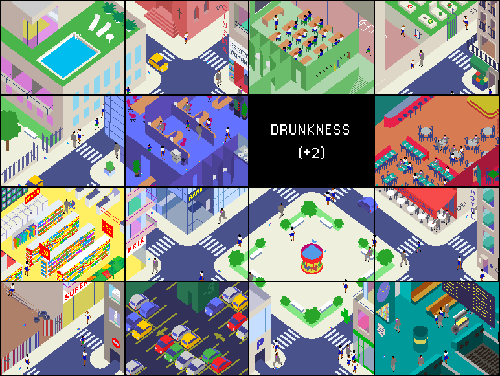| Vigilance
1.0
video surveillance game, cdrom, 2001
The player faces
a series of screens allowing him to watch over many places in the same time :
streets, supermarkets, parking lots, shops, apartment buildings, schools, etc.
Denouncement is his aim. In a limited time (his work time), he has to point out
the most important amount of infractions : robberies, pocket-pickings, burglaries,
shop-lifts, breaches of the highway code, trash-abandoning, drug dealing, solicitation
on a public place, procuring, drunkenness, sexual harassment, adultery, incest,
pedophilia, zoophilia, necrophilia, etc. Each time the player catch one in the
act, his points increase ; each time he defames, they lower. Each citizen being
a virtual offender, all unpunished infractions increase the rate of amorality
of the society. A mere vigilance would lead to a moral purification, and back
to the spirit of effort, family, solidarity. An inadequate vigilance would necessarily
plunge the population into chaos and depravity.
Prevented from using
his critical sense by the lure of success, the player faces a double bind : while
he still plays the part of the unrelenting lover of justice, he becomes conscious
that to play the game is in a way to play against the discourse of the game. At
the end, the denunciation of a controlled society, the total visibility and spying,
puts him in a position of self-denunciation.
Le
joueur est face à une série d'écrans qui lui permettent de
surveiller simultanément de nombreux lieux: rues, supermarchés,
parkings, boutiques, immeubles, écoles, etc. Son objectif est la délation.
Dans un temps limité (son temps de travail), il doit déceler un
maximum d'infractions: cambriolages, vols d'autoradio, transgressions du code
de la route, abandon de détritus, deal de drogue, racolage, proxénétisme,
alcoolisme sur la voie publique, attentats à la pudeur, détournement
de mineur, harcèlement sexuel, adultères, incestes, pédophilie,
zoophilie, nécrophilie, etc. A chaque flagrant délit, le score augmente,
à chaque diffamation, il baisse. Chaque citoyen étant un délinquant
en puissance, toute infraction impunie augmente le taux d'amoralité de
la société. Une bonne vigilance entraînera un assainissement
des mœurs, un retour du sens de l'effort, de la famille et de la solidarité.
Une vigilance insuffisante plongera immanquablement la population dans le chaos
et la turpitude.
Empêché d'exercer son esprit critique par l'appât
du score, le joueur se trouve confronté à un paradoxe: il continue
à se comporter en justicier implacable tout en comprenant peu à
peu que jouer le jeu, c'est jouer contre le discours du jeu. Les lieux où
la dénonciation opère - critique de la société de
contrôle, de la visibilité totale, de l'espionnage généralisé
-, déguisés sous des écrans qui rappellent des jeux d'enfance,
placent finalement le joueur en position de se dénoncer lui-même
Conception and animation : Martin Le Chevallier.
Scenery
: Martin Le Chevallier and Yann Le Béchec
Programming : Julien Alma
Exhibitions of Vigilance 1.0 / Expositions
présentant Vigilance 1.0
– "Dial 33 then
1", demonstration organized by Cristina Ricupero, in September 2000, in the
Kiasma Museum in Helsinki;
– "Connivence", Biennale de Lyon
(France), from June 22 to September 23 2001.
– "Northern Fundamentalism",
exhibition organized by Charlottenborg Exhibition Building, Copenhagen and NIFCA
(Nordic Institute of Contemporary Art, Helsinki). Curators: Lars Bang Larsen,
Cristina Ricupero and Charlotte Brandt. From October 31 to December 8 2002.
– «BananaRAM», from the 6th to the 11th of June 2004 in Ancona
(Italy).
– “Games with an agenda”, exhibition organized by
Gonzalo Frasca and Ian Bogost in the Curzon Soho, from October 16 to November
7 2004, in London.
– "Just believe", personal exhibition in
the Maisonneuve gallery, from January to February 2005, in Paris.
– "GameScenes",
exhibition in the "Piemonte Share Festival", from February 25 to March
1 2005, in Torino (Italy).
| |
|
